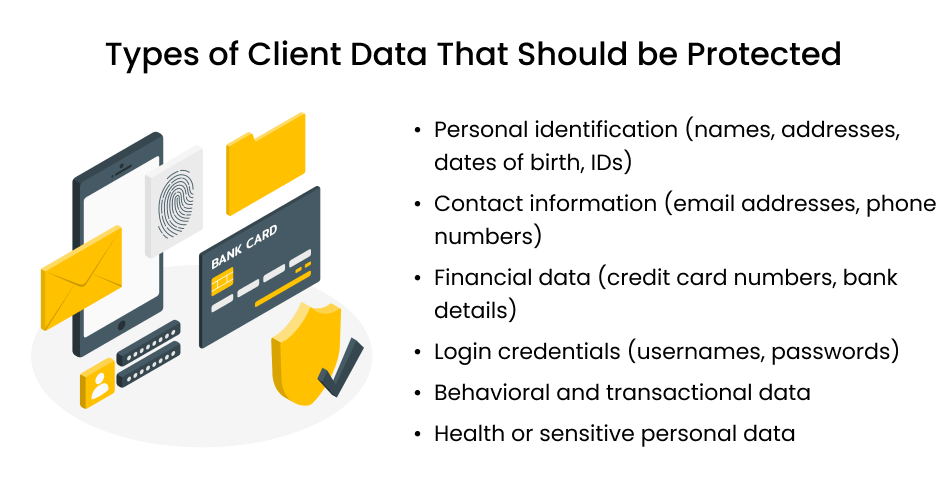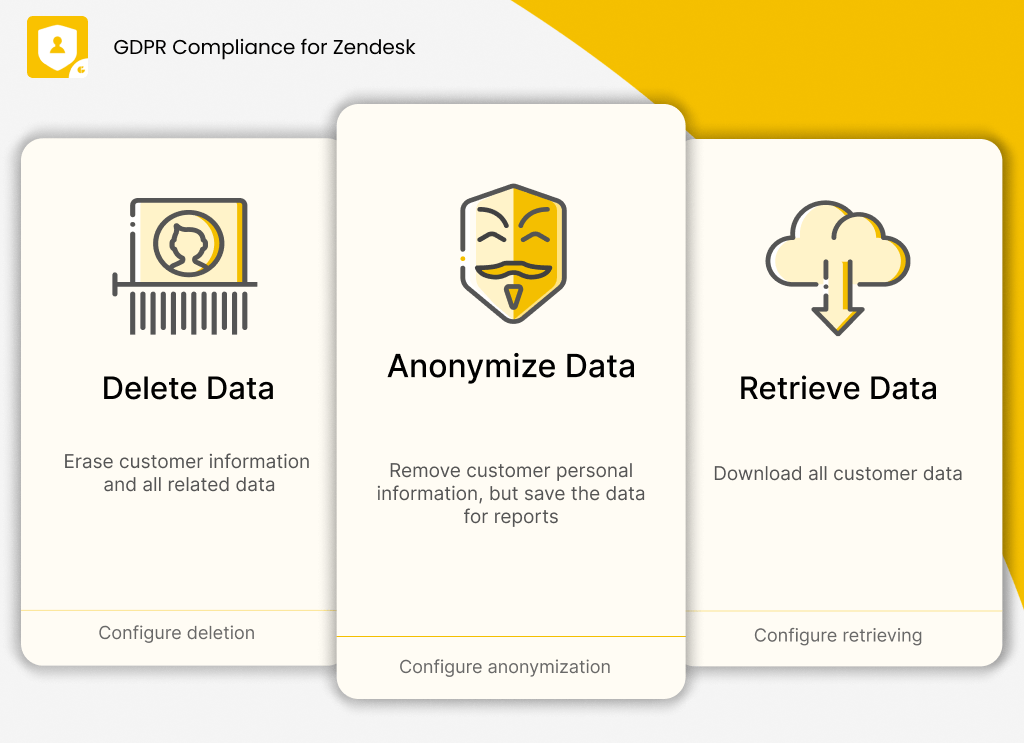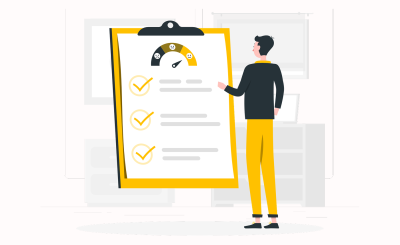Sounds terrifying, right? But how is that possible?
Cybercriminals exploit system vulnerabilities, steal data, and either resell it or hold it for ransom. That’s why it’s crucial to protect customer information at every point, both to safeguard your customers and to protect your business from potential losses.
What is Customer Data Protection?
Customer data protection is the practice of keeping personal information safe from unauthorized access, misuse, or theft. This includes names, email addresses, phone numbers, payment details, and any other information your business collects from customers.
The goal is simple: prevent data breaches, maintain trust, and comply with legal requirements. Protecting customer data isn’t just about technology; it also involves processes, policies, and staff awareness.

How Customer Data Protection related with GDPR?
The General Data Protection Regulation (GDPR) is a legal framework designed to ensure the customer data security of EU citizens. Any company handling this data must follow strict rules for collection, storage, and processing.
Key principles include:
- Collect only what you need: Avoid gathering unnecessary data.
- Limit access: Only authorized staff should handle sensitive information.
- Ensure security: Use strong passwords, encryption, and secure storage.
- Transparency: Inform customers about what data you collect and how you use it.
Following GDPR not only avoids fines and legal risks but also strengthens customer trust. Even businesses outside the EU benefit from applying similar standards, as customers increasingly expect data protection.
Importance of Customer Information Protection
If you or your business do not pay attention to customer data security, it means that you are prone to hacks. This, in turn, may lead to a decrease in customers' trust, their leaving, and even fines and lawsuits against your company.
A well-known example is Equifax. In 2017, a breach exposed 147 million records, including social security numbers, birth dates, and addresses. The fallout cost the company over $1 billion in settlements and regulatory fines. More recently, in 2024, National Public Data suffered a breach affecting 2.9 billion records, showing that even large organizations remain vulnerable.
So, how do companies protect customer data to avoid such outcomes?
One essential step is complying with key data protection laws. The General Data Protection Regulation (GDPR) sets rules for handling EU citizens’ personal data, while the California Consumer Privacy Act (CCPA) does the same for California residents. Ignoring these regulations can result in severe penalties, making compliance both a legal and practical necessity.
What Types of Client Data Should be Protected?
Not all customer data carries the same level of risk, but certain types are especially sensitive and crucial to effective client data protection:
- Personal identification: Names, addresses, dates of birth, and government-issued IDs.
- Contact information: Email addresses, phone numbers, and mailing addresses.
- Financial data: Credit card numbers, bank details, and payment histories.
- Login credentials: Usernames, passwords, and security questions.
- Behavioral and transactional data: Purchase history, website activity, and preferences.
- Health or sensitive personal data: Any information revealing medical conditions or other highly confidential details.
Protecting these categories is crucial for preventing identity theft, fraud, and reputational damage. Even seemingly “low-risk” information, like email lists, can be valuable to cybercriminals if combined with other data.

Best Practices to Protect Customer Data in Compliance with GDPR
There are several rules you need to follow to guarantee GDPR compliance and understand how to protect customer data effectively. Here are some of the minimum security standards:
Gather only crucial information
Collecting valuable data is one of the critical aspects of privacy regulation, according to GDPR customer data privacy laws. When you decide to gather only the crucial and practical information from your customers, you will get the following outputs:
- decrease in the external value of the customer data;
- increase in the confidence of your customers.
What do these mean for your marketing and company?
The process of decreasing the value of your data improves your customer data security, as web hackers and scammers won't be interested in low-value information. For example, a simple email list is less attractive than full personal profiles. Customers also feel more confident sharing information when forms ask only for what’s necessary.
But how to understand that the data you want to collect is precious?
It is simple, just ask yourself: Will this data change how you market or serve your customers?
Review your data at least once a year and remove what’s unnecessary. Also, check all channels where you collect data (web forms, apps, analytics, or in-store) to ensure only essential information is gathered.
Train your employees on data privacy
Human mistakes cause many data breaches. Typically, cybercriminals trick employees into clicking on a link or installing some malware application from the web to infect their gadget (mobile phone, tablet, or computer) with a virus and steal data.
Spoofing or making employees believe that they are sending the data to a trusted person is a popular method of cybercriminals, too. That is why it is essential to train your employees on cybersecurity to make them understand the necessity of protecting both client data and the company's private data.
Set limitations on your data
Not every team member needs full access to customer data, and not all access needs to be the same. Limiting permissions reduces security risks.
So, if, for instance, you have 50 members in your team, that means 50 points of vulnerability (!). What is more, if one of them uses a weak password, this automatically makes your system super prone to a hacker attack.
When you set access restrictions, this also helps reduce the chances of internal data abuse. What is that? For instance, some employees are fired but still get access to your cloud-based system. In this case, they can do whatever they like. But this situation can easily be prevented if you limit their admission in the first place.
Use password management solutions
Every login or shared account is a potential security risk. Password management tools let your team create strong, unique passwords and store them securely. These tools often encrypt passwords, making them unreadable to anyone without access, including hackers.
They also simplify shared access. Team members can use the credentials they need without knowing the actual passwords. If someone leaves the company, their access can be revoked immediately, keeping your accounts secure. Using password management reduces human error while strengthening overall user data protection.

Stay current with software and systems
Outdated software is an open door for cybercriminals. Hackers exploit known vulnerabilities in old systems, sometimes with devastating results. Applying updates and security patches promptly closes these gaps. Imagine a hacker exploiting an unpatched system while your team is unaware, but keeping software updated prevents that scenario.
Don't use too many data silos
Using various data silos could also become a cause of data vulnerability, especially if your data silos are stored in different and unsecured places. Besides, you may easily forget where specific data is stored, and consequently, you won't even notice a data breach. What to do then?
Try to create a strategy for protecting customer data where you describe how to deal with all your data and where to store it. You can also use a data tracking plan that will help you trace which data you are collecting and why you are collecting this data.
Opt for sophisticated encryption methods
The use of encryption is one of the best privacy practices. It is essential to opt for advanced data encryption methods to improve your online privacy. Do not use badly encrypted cloud solutions, but take advantage of the decentralized database that works with SHA 256-bit encryption security protocols.
Check third-party security practices
Third-party vendors can be weak points in your consumer data security. Any service that handles customer data needs to follow strong protection practices. Before sharing information, check that vendors comply with security standards and data protection laws. Otherwise, a breach on their side could become a breach for your business too.
Start building trust
Protecting customer data is also about relationships. When customers know their information is handled securely, they feel confident sharing it. This trust strengthens loyalty and encourages long-term engagement.
Being transparent matters too. Explain what data you collect, why you need it, and how it’s protected. A clear privacy policy and open communication show customers that their safety is a priority, not just a legal requirement.
Review systems and processes regularly
Even strong systems can have hidden vulnerabilities. Regular audits help you identify weaknesses before hackers do. Reviewing your processes, permissions, and software ensures that potential issues are caught early. Think of audits as preventive maintenance: a small effort now can prevent a major breach later.
Create a clear privacy policy
Make sure your company stays transparent with your customers about the data you collect throughout each point of the customer journey. For this, create a clear privacy policy to present your customers with protection requirements and make it customer-friendly, omitting too much legalese.
Risks of Poor Consumer Data Protection
Failing to protect customer data can have serious consequences for your business. The risks go beyond fines and legal penalties:
- Loss of trust: Customers are unlikely to continue doing business with a company that fails to safeguard their information. Trust, once lost, is hard to rebuild.
- Financial impact: Data breaches can be costly. Businesses may face fines, lawsuits, or the expense of investigating and fixing security gaps.
- Reputational damage: News of a breach spreads quickly. Even a single incident can harm your brand for years.
- Operational disruption: Breaches often require shutting down systems, investigating incidents, and restoring services, which interrupts day-to-day operations.
All Customer Data Protection Regulations
Customer data protection is governed by a growing number of laws worldwide. While GDPR and CCPA are the most widely known, many other countries have their own regulations setting standards for how businesses collect, store, and process personal information.
For example, Canada’s PIPEDA and Brazil’s LGPD set clear rules for handling personal data, similar to GDPR. China’s PIPL and Australia’s Privacy Act also impose strict requirements, showing that data protection is a global concern.
These laws often cover what data can be collected, how it must be stored and protected, and what steps to take in case of a breach. Staying aware of these regulations helps companies avoid fines and reputational damage.
Wrapping Up
If you are running a digital business and dealing with people's sensitive data, your responsibility is to keep your customer data secure. By building a strong data security and data collection strategy and aligning with GDPR customer data protection requirements, you will be able to gain customers' trust and avoid any potential fees or lawsuits. We hope our article on how to keep your customer data safe will come in handy once you decide to change your approach to security and improve it.
Customer Data Security FAQs
Are there any tools that can make the process of customer data collection easier?
Yes, sure. There are many data collection software that can help you comply with the GDPR protection laws. For instance, GDPR Compliance for Zendesk is an easy tool to process customers' data in the Zendesk help desk. It helps delete, anonymize, and even download your users' data from Zendesk in just a few clicks.
What are the reasons why to protect your customers' personal data?
You can safeguard your company from any potential threats like data breaches, cybercriminals' hacks, fines, and lawsuits by taking steps to protect customer information.
Can GDPR and its protection principles apply to personal data?
GDPR only applies to businesses that collect personal data on EU citizens. However, if you want to find out how it may affect your very firm, you can consult a lawyer.
What is the action plan for customer data protection?
If you want to secure customer data, you have to follow these simple steps:
- Gather only valuable data from your customers
- Restrict access to your data
- Take advantage of password management solutions
- Avoid using unsecured data silos
- Improve your security standards








